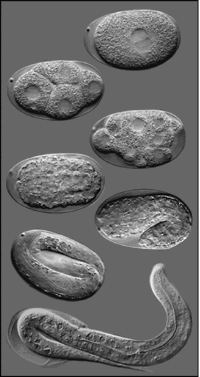Hundreds of worms taken for experimental purposes aboard the space shuttle Columbia were found among the remains of the spacecraft. This was announced yesterday by the American Space Agency
 The worm C. elegans, of the type found among the Columbia fragments
The worm C. elegans, of the type found among the Columbia fragments
Hundreds of worms taken for experimental purposes aboard the space shuttle Columbia were found among the remains of the spacecraft. This was announced yesterday by the American Space Agency (NASA).
The worms, of the type C. elegans and a substance known as moss that was attached to them, were found a few weeks ago among the remains of the shuttle in Texas, but only this week the technicians sorting the remains of the shuttle at the Kennedy Space Center in Florida opened the containers of worms. All seven astronauts on board the shuttle, including Israeli astronaut Ilan Ramon, were killed when the shuttle disintegrated over Texas on February 1 of this year. Columbia performed about 60 scientific experiments during its last flight. "To the best of my knowledge, these are the only live cell experiments that have been located and identified," said Bruce Buckingham, a NASA spokesman at the Kennedy Space Center.
The worms, which are about the size of a pencil tip, were part of an experiment to test a synthetic feed formula. Since their life span is between seven and ten days, the worms found were fourth or fifth generation worms that were put into the shuttle before it flew into space in January. It is a species of worms that are considered primitive creatures, some of whose characteristics resemble those of humans. In 1999, C. elegans was the multicellular species
The first to have their genome decoded.
The worm experiment was done by researchers at NASA's Ames Research Center in California. The moss, known as Ceratodon, was used to study the effect of gravity on cells. During the Columbia flight, space shuttle commander Rick Hasband sprayed the moss with a chemical that destroyed the protein fibers. He also sprayed the moss with formaldehyde, to preserve it. So far, seven of the eight aluminum containers that contained the moss have been found.
Dr. Fred Sack from Ohio University, said that "it's amazing how the cells were preserved, but it's not clear if it can actually still bring benefit." NASA officials said they don't know if the worms still have any scientific value because the test was scheduled to take place within hours of Columbia's landing. "It's amazing that there is a possibility to get data after what happened," said Sack. "We expected the moss to melt at the time of the crash
